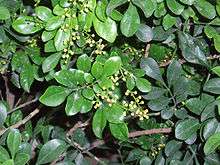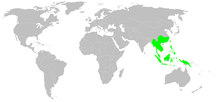Aglaia odorata
Aglaia odorata is a species of plant in the family Meliaceae. It is found in Cambodia, China, Indonesia, Myanmar, Taiwan, Thailand, Vietnam, and possibly Laos.[1]
| Aglaia odorata | |
|---|---|
 | |
| Scientific classification | |
| Kingdom: | Plantae |
| Clade: | Tracheophytes |
| Clade: | Angiosperms |
| Clade: | Eudicots |
| Clade: | Rosids |
| Order: | Sapindales |
| Family: | Meliaceae |
| Genus: | Aglaia |
| Species: | A. odorata |
| Binomial name | |
| Aglaia odorata | |
 | |
It is occasionally sold as a house plant under the name "Chinese perfume plant." It can be grown outdoors in USDA zones 9 and 10.
| Wikimedia Commons has media related to Aglaia odorata. |
Description
Aglaia odorata is a small tree that retains its green leaves throughout the year, and can reach a height of 2 to 5 meters. It is multiple branched and its leaves are 5 to 12 centimeters long. It has small golden yellow raceme oval-shaped flowers with 6 petals. The fruit is red, about one centimeter long and egg-shaped, containing one to two seeds.[2]
Uses
Traditional medicinal use
Many parts of Aglaia odorata - roots, leaves, flowers and branches - can be used as medicine.
- The roots are boiled with water to make a drink to increase appetite. n the Philippines, the roots and leaves can be used as a tonic.[3]
- The dried flowers are used to cure mouth ulcers and reduce fever.[2]
- In China, the dried branches and leaves are boiled in water and used to reduce pain from rheumatic joints, injuries from falls, superficial infections and toxic swelling.[4]
Perfume
The dried flowers can be used to produce perfume for clothes and mixed into cigarettes.[3]
Herbicide
Aglaia odorata can be used as an organic herbicide to control grass and weeds in fields, such as rice fields and maize fields.[4]
References
- "Aglaia odorata". The IUCN Red List of Threatened Species. Retrieved 20 August 2007.
- "ประยงค์ สรรพคุณและประโยชน์ของต้นประยงค์ 24 ข้อ". frynn. Retrieved 30 August 2015.
- "Sinamomong-sungsong". Stuartxchange. Retrieved 30 August 2015.
- "Aglaia odorata Lour". School of Chinese Medicine. Archived from the original on 10 May 2015. Retrieved 30 August 2015.
External links
- Aglaia odorata Lour. Medicinal Plant Images Database (School of Chinese Medicine, Hong Kong Baptist University) (in Chinese) (in English)
